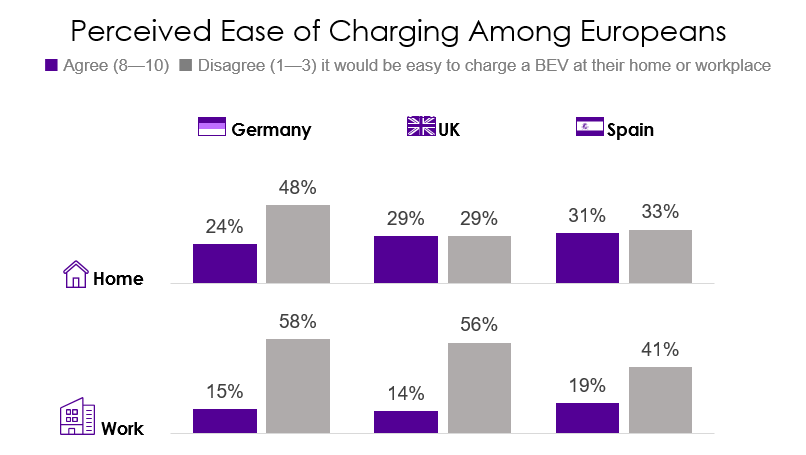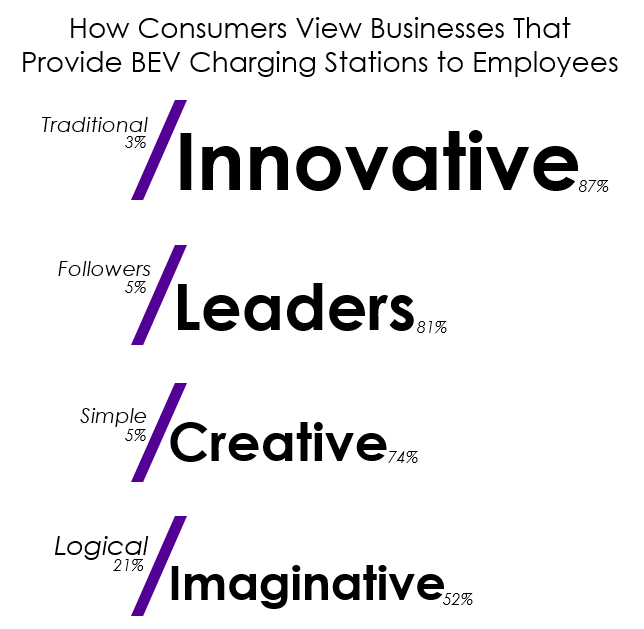
Battery electric vehicle (BEV) sales are rising worldwide, with some predicting that nearly 15% of all global vehicles will be electric . However, despite the automobile industry’s focus on electrifying vehicles and some receptivity among global citizens, consumers still feel anxious about BEV journey range and charging infrastructure. These top two barriers to BEV adoption are well-known among manufacturers pushing battery electric vehicle research and development as fast as they can. Until the BEV industry makes charging at home and work easier as well as increases the visibility and density of public charging points, consumers’ perception of risk in taking long journeys in BEVs will remain high.
Escalent’s Automotive & Mobility team recently explored these issues in a self-funded study and uncovered some good news: Businesses can create a win-win scenario for their brand, consumers and BEV manufacturers if these businesses provide BEV charging stations for employee use.
Consumer Attitudes toward BEV Charging at Home and at Work
We first looked into the impact of BEV charging stations and signage on purchase consideration and found an important correlation: approximately 30% more US consumers said they would consider purchasing a BEV because they saw charging stations and signage. This is good news because it signals that consumers would be receptive to purchasing an electric vehicle when charging infrastructure becomes more ubiquitous.
Next, we dug into consumer attitudes in the US and Europe toward BEV charging at home and at work. We found that relatively few European vehicle owners think it would be easy to charge a BEV at their home or workplace, and we’ve seen similar trends among US car owners.
The ease of BEV charging at home heavily depends on where consumers live. It is relatively easy to charge in the driveway of a suburban home but massively challenging for residents of apartment blocks or urban houses lacking off-street parking.
When asked about the ease of charging at work, opinion is even more negative—more than half of consumers believe that lack of work charging options will remain the reality.

Business Impact on BEV Adoption by Providing Charging Stations
We then conducted research on BEV charging stations at workplaces in the US among both BEV and internal combustion engine (ICE) owners to see if consumer consideration of electric vehicles changes in relation to the availability of workplace charging stations. We hypothesized that consumers would be more inclined to consider BEVs if their workplace made charging stations available for employee use.
And our hypothesis was correct: 38% of individuals who did not initially consider an electric vehicle and whose workplace did not currently offer charging infrastructure would consider a BEV if their workplace made charging stations available for employee use.
We also found that almost one-quarter (23%) of respondents who commute to work today have employers that offer BEV charging stations. Among those with a charging station at their place of work, nearly half indicate they do not have to pay to use the station.
Business Benefit from Providing BEV Charging Stations
While a confusing picture is emerging of who is responsible for creating and offering BEV charging infrastructure, businesses can encourage BEV adoption by providing charging stations to their employees. This investment is advantageous for businesses because it will attract forward-thinking, tech-savvy, environmentally conscious employees. The company will reap the added corporate benefit of being perceived by current and future employees as an innovative, creative and imaginative corporate leader. Businesses investing in workplace BEV charging stations, alongside manufacturers, mobility providers and other diverse players working to address consumers’ anxieties about electric vehicles, will raise the density and visibility of charging infrastructure for consumers. Motorists will increasingly feel that BEVs are accessible, which is a win-win for everyone involved.

The development of the BEV industry is a key focus of our team as we continue to work closely with auto manufacturers, mobility companies and other stakeholders. To learn more about how the BEV industry can overcome barriers to adoption and encourage consumer purchase consideration, read our latest report: The Future of BEV: How to Capture the Heart and Minds of Consumers.
Methodology: Escalent interviewed a US-based sample of 188 BEV owners, 86 Plug-In Hybrid Electric Vehicle owners and 1,895 ICE owners at least 18 years of age in July to October of 2019. Respondents were recruited from the Escalent-managed My Driving Power Insight Community and the My Auto Voice Insight Community. Due to their opt-in nature, these communities (like most others) do not yield a random probability sample of the target population. As such, it is not possible to compute a margin of error or to statistically quantify the accuracy of projections. Escalent will supply the exact wording of any survey question upon request.










